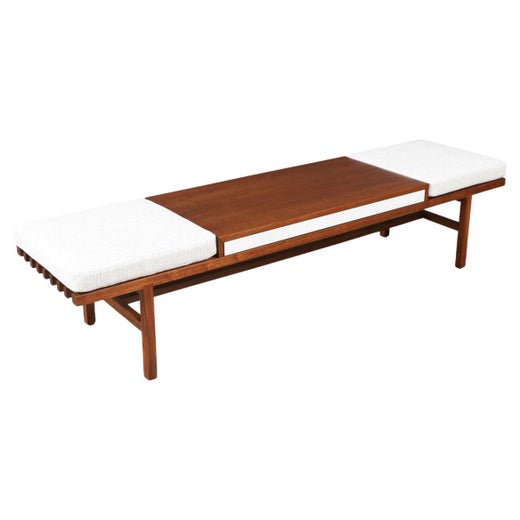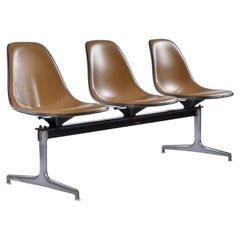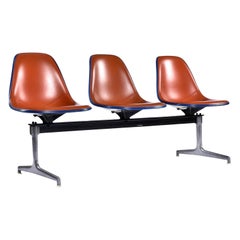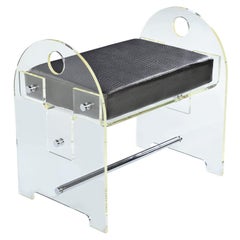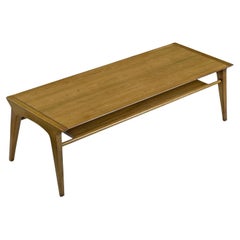John Keal Expanding Slat Bench in Beech Wood
About the Item
- Creator:John Keal (Designer)
- Similar to:George Nelson (Designer)
- Dimensions:Height: 12.25 in (31.12 cm)Width: 96 in (243.84 cm)Depth: 18.38 in (46.69 cm)Seat Height: 12.25 in (31.12 cm)
- Style:Mid-Century Modern (In the Style Of)
- Materials and Techniques:
- Place of Origin:
- Period:
- Date of Manufacture:1950s
- Condition:Refinished. Wear consistent with age and use. We stripped off the old milky (grey-green) opaque stain that concealed the beautiful honey color beech wood and finished with a natural clear. You simply won't a find a nicer version of this anywhere. Only very minor imperfections remain (see pics).
- Seller Location:Chattanooga, TN
- Reference Number:1stDibs: LU2255323894222
John Keal
At a time when many furniture makers were turning to cheaper materials for mass production, mid-century modern designer John Keal didn't shy away from utilizing quality woods in his work, like mahogany and walnut to create his coffee tables, cabinets and benches.
While little is known about Keal, he was part of a powerhouse group that collaborated with Los Angeles furniture manufacturer Brown-Saltman in the 1940s and ‘50s. Other designers who had partnered with the firm during the mid-20th century included Greta Magnusson Grossman, Paul Frankl, Paul Laszlo, and Gilbert Rohde, a New York City-born designer who would help legendary Michigan furniture manufacturer Herman Miller avert financial disaster during the Great Depression.
Brown-Saltman was established in 1923 and initially specialized in reproductions of furniture in period styles. When cofounder David Saltman met Frankl, the firm had discontinued its Early California collection and was producing modern furniture.
The Austrian-born Frankl was already a big name in decorating in California in the late 1930s — his clients were Hollywood movie stars who were drawn to pieces such as his Art Deco-style Skyscraper series and other biomorphically shaped designs that showed the influence of Chinese and Japanese forms (Brown-Saltman’s offerings were frequently demonstrative of Asian influences). Frankl had become interested in producing inexpensive furniture for middle-class consumers, and his 1940s-era collaboration with Brown-Saltman was a success — print advertisements touted his name as well as the fact that these furnishings, which drew on the clean lines of chrome-framed Bauhaus pieces but instead integrated organic materials, were intended for modern homes.
Keal’s work also fit snugly into what we now call California modernism, which derived from the Bauhaus and International Style movements, and revolutionized the way we build homes today, not only in the Golden State but across the globe. Keal created sleek end tables in walnut and topped with enameled copper and upholstered low-profile dining chairs framed in bleached mahogany for Brown-Saltman as well as other West Coast mid-century brands such as Glenn of California and Modeline.
Find vintage John Keal seating, storage pieces and tables on 1stDibs.
You May Also Like
Vintage 1950s American Mid-Century Modern Benches
Mahogany
20th Century American Mid-Century Modern Benches
Walnut
Mid-20th Century American Benches
Wood, Hardwood, Walnut
Mid-20th Century Macedonian Mid-Century Modern Coffee and Cocktail Tables
Wood
21st Century and Contemporary American Mid-Century Modern Benches
Stainless Steel, Chrome
Vintage 1950s American Mid-Century Modern Benches
Maple
Mid-20th Century Italian Mid-Century Modern Benches
Metal, Brass
Mid-20th Century American Mid-Century Modern Benches
Wood, Birch
Vintage 1960s Dutch Mid-Century Modern Coffee and Cocktail Tables
Wenge
2010s American Modern Benches
Walnut
More From This Seller
View AllVintage 1970s American Mid-Century Modern Benches
Metal, Aluminum
Vintage 1970s American Mid-Century Modern Benches
Metal, Aluminum
Vintage 1970s American Post-Modern Stools
Lucite, Faux Leather, Acrylic
Vintage 1950s American Mid-Century Modern Coffee and Cocktail Tables
Fruitwood, Walnut
Vintage 1950s American Mid-Century Modern Coffee and Cocktail Tables
Bamboo, Rattan
Late 20th Century American Hollywood Regency Coffee and Cocktail Tables
Hardwood
Recently Viewed
View AllRead More
A Guide to Herman Miller’s Most Iconic Furniture
The prolific manufacturer has partnered with many of the world’s top designers since opening its doors in 1923. Here are some of the company’s greatest hits, which helped transform the American home and office.
Kule and Forsyth Give Iconic Furniture a Bold Makeover with Stripes
Maggie and Anne Genovese, of Forsyth, teamed up with fashion designer Nikki Kule to reimagine some classic pieces.
